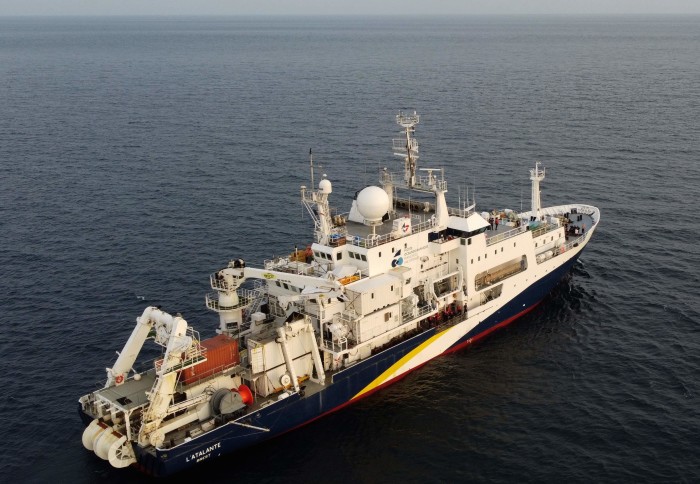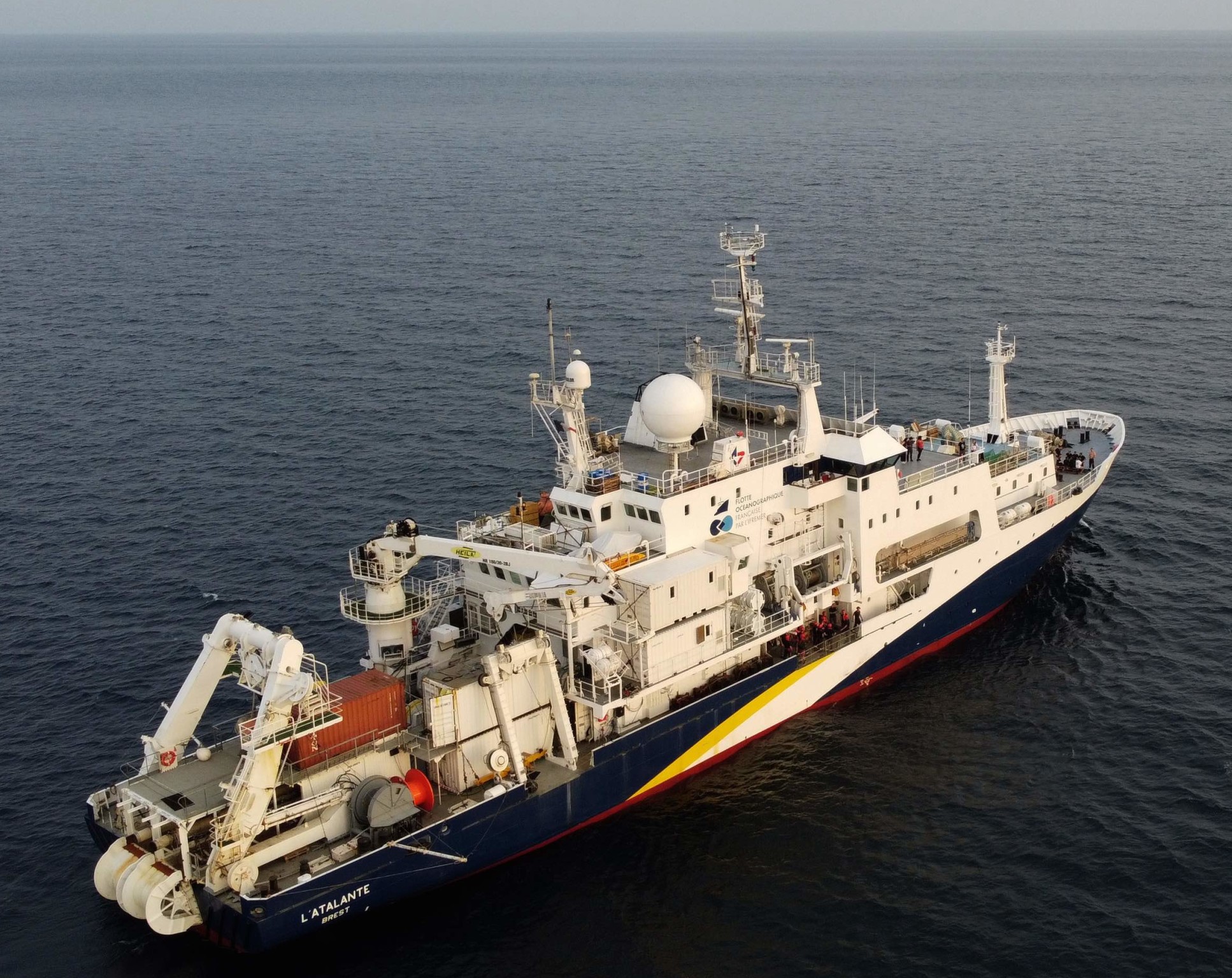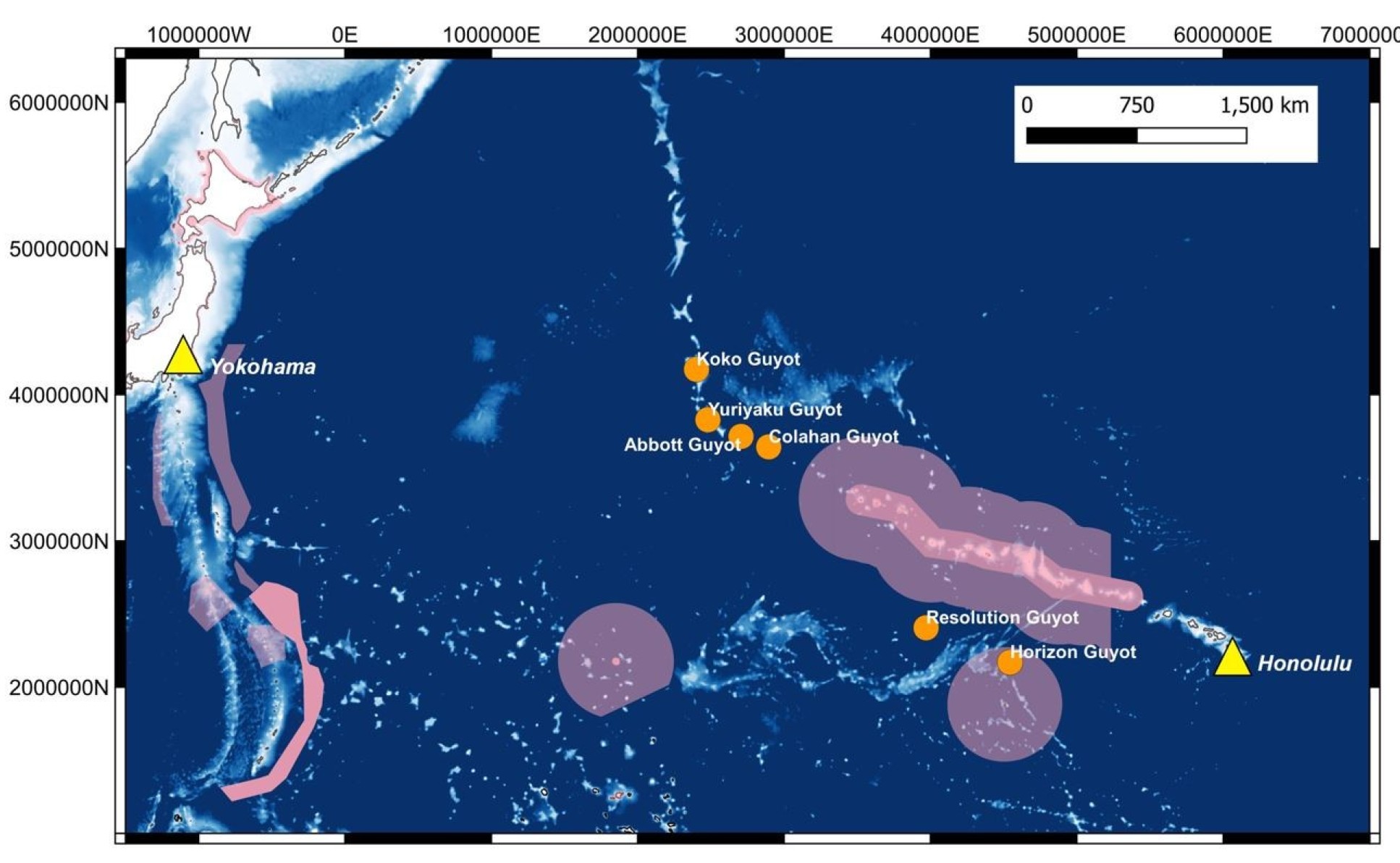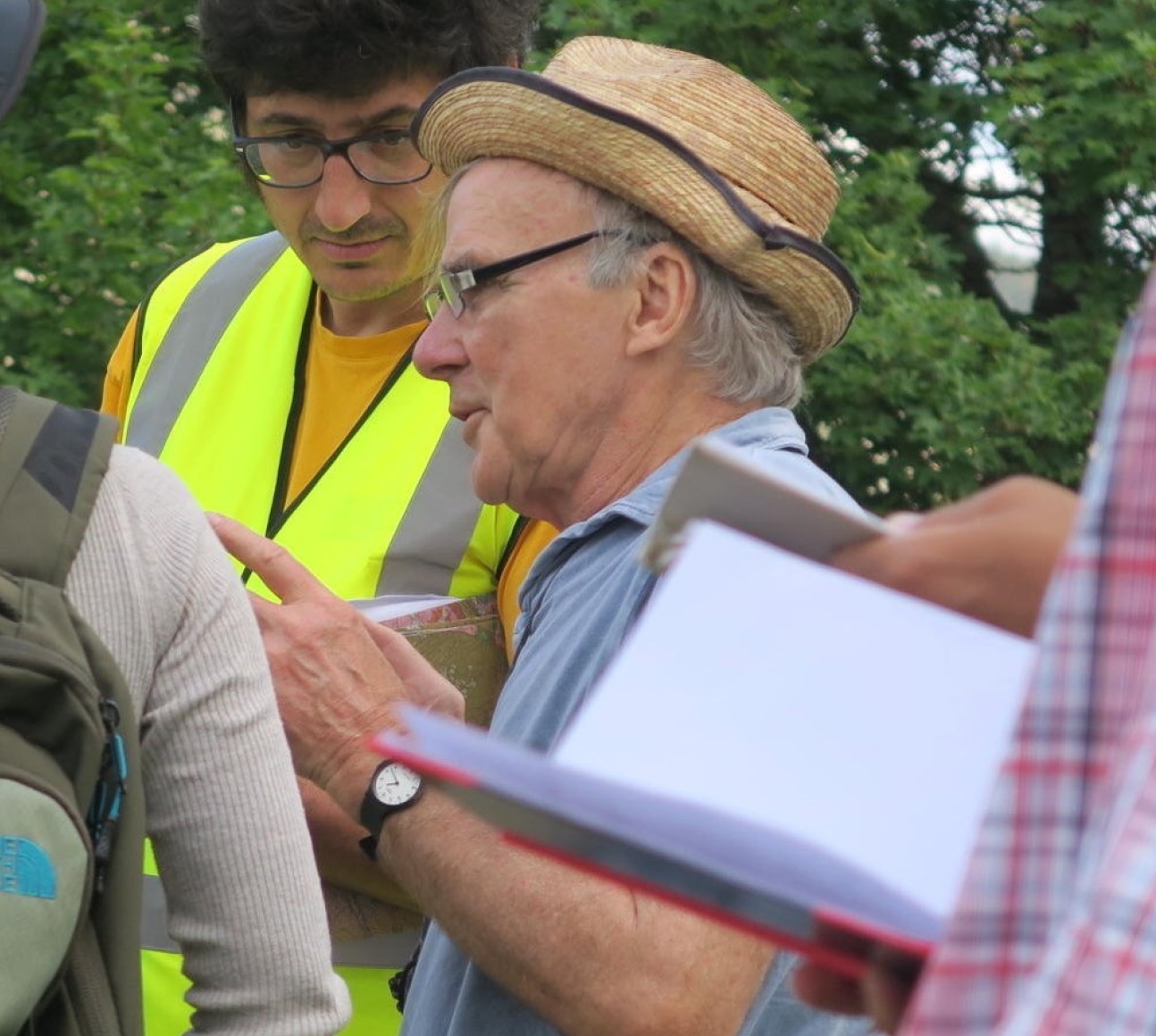
L‘Atalante research vessel, which collects seismic data as part of the HIPER2 expedition

An overview of the recent publications, events and exciting work that's been happening in the Department of Earth Science and Engineering.
Contents
Publications
Research Activity
Fieldwork
Research Grants
Outreach
Awards
Media Mentions
Publications
Clare, M. C. A., Wallwork, J. G., Kramer S. C., Weller, H., Cotter, C. J. & Piggott, M. D. (2022). Multi-Scale Hydro-Morphodynamic Modelling using Mesh Movement Methods. GEM – International Journal on Geomathematics, 13, 1-39. DOI: 10.1007/s13137-021-00191-1
Cole, K., Brito-Parada, P., Hadler, K., Mesa, D., Neethling, S., Norori-McCormac, A., Cilliers, J.J. (2022). Characterisation of solid hydrodynamics in a three-phase stirred tank reactor with positron emission particle tracking (PEPT). Chemical Engineering Journal. DOI: https://doi.org/10.1016/j.cej.2021.133819
Cole, K., Barker, D., Brito-Parada, P., Buffler, A., Hadler, K., Mackay, I., Mesa, D., Morrison, A., Neethling, S., Norori-McCormac, A., Shean, B., Cilliers, J.J. (2022). Standard method for performing positron emission particle tracking (PEPT) measurements of froth flotation at PEPT Cape Town. Methods X. DOI: https://doi.org/10.1016/j.mex.2022.101680
Mesa, D., Quintanilla, P., Reyes, F. (2022). Bubble Analyser – An open-source software for bubble size measurement using image analysis. Minerals Engineering, 180, 107497. DOI: 10.1016/j.mineng.2022.107497
Saceanu, M.C., Paluszny, A., Zimmerman, R.W., Mas Ivars, D. (2022). Fracture growth leading to mechanical spalling around deposition boreholes of an underground nuclear waste repository. International Journal of Rock Mechanics and Mining Sciences, 152, paper 105038. https://doi.org/10.1016/j.ijrmms.2022.105038
Salter, T.L., Magee, B.A., Waite, J.H. & Sephton, M.A. (2022) Mass Spectrometric Fingerprints of Bacteria and Archaea for Life Detection on Icy Moons, Astrobiology, 22, 2, 143-157. DOI: 10.1089/ast.2020.2394
Samuel J-S, Muggeridge A.H. (2022), Fast modelling of gas reservoir performance with proper orthogonal decomposition based autoencoder and radial basis function non-intrusive reduced order models. Journal of Petroleum Science and Engineering. 211:110011. doi: https://doi.org/10.1016/j.petrol.2021.110011.
Samuel J-S, Muggeridge A.H. (2022), Non-Intrusive Reduced Order Modelling for the fast simulation of gas reservoirs. Journal of Natural Gas Science and Engineering. 101:104527. doi: https://doi.org/10.1016/j.jngse.2022.104527.
Selley, R.C. (2021) Dorking, Darwin and the Arthur Russel Wallace Mystery. Geologists' Association Mag. Vol. 24. No. 4. 36-37.
Singh, D.K., Brito-Parada, P.R., Bhutani, G. (2022). An open-source computational framework for the solution of the bivariate population balance equation. Computers & Chemical Engineering 107780. DOI: https://doi.org/10.1016/j.compchemeng.2022.107780
Strullu-Derrien, C., Spencer, A.R.T., Cleal, C.J., Leshyk, V.O. (2022). The 330–320 Million-Year-Old Tranchée des Malécots (Chaudefonds-sur-Layon, South of the Armorican Massif, France): a Rare Geoheritage Site Containing In Situ Palaeobotanical Remains. Geoheritage 14, 42. DOI: https://doi.org/10.1007/s12371-022-00673-0
Wallwork, J. G., Knepley, M. G., Barral, N. & Piggott, M. D. (2022). Parallel Metric-Based Mesh Adaptation in PETSc using ParMmg. 30th International Meshing Roundtable. DOI: 10.48550/arXiv.2201.02806.
Wallwork, J. G., Mackie, L., Kramer, S. C., Barral, N., Angeloudis, A. & Piggott, M. D. (2022). Goal-Oriented Metric-Based Mesh Adaptive Tidal Farm Modelling. 9th International Conference on Computational Methods in Marine Engineering. DOI: 10.2218/marine2021.6795.
Wallwork, J. G., Barral, N., Ham, D. A. & Piggott, M. D. (2022). Goal-Oriented Error Estimation and Mesh Adaptation for Tracer Transport Modelling. Computer-Aided Design, 145:103187. DOI: 10.1016/j.cad.2021.103187
Research Activity
Diego Mesa and Pablo Brito-Parada completed a three-weeks Positron Emission Particle Tracking (PEPT) campaign in the University of Birmingham. During this period, they performed the largest PEPT experiment in records, using a custom-built modular PET camera of over 2m high. Their work will enable the characterisation of the complex hydrodynamics of a pilot-scale multiphase flotation cell.
Fieldwork
Michele Paulatto (ESE Advanced Research Fellow) has joined scientists from Géoazur (CNRS/IRD/Observatoire de la Côte d’Azur/Université de la Côte d’Azur), Karlsruhe Institute of Technology, Instituto Geofísico / Escuela Politécnica Nacional (IG-EPN, Quito) and Instituto Oceanográfico de la Armada del Ecuador (INOCAR, Guayaquil) on the French research vessel l’Atalante for an expedition along the coast of Ecuador.
The expedition, called HIPER2 (High Resolution Imaging of the subduction fault in the Pedernales earthquake rupture zone) is the second part of a field campaign to explore the Ecuadorian subduction zone, that started in March 2020, but was interrupted by the COVID pandemic after only 10 days at sea.
The coast of Ecuador near the town of Pedernales was hit by a magnitude 7.8 earthquake in April 2016. This was the strongest earthquake to affect Ecuador in 70 years, causing hundreds of victims and economic losses exceeding 500 million dollars. This earthquake was caused by the sudden rupture of the megathrust fault at a depth of 20 km. The rupture extended over an area of 100 x 30 km2 and caused violent shaking in the Pedernales region. The shallow part of the megathrust fault is characterized by slow slip earthquakes that can last from a few days to months and do not generate shaking (they are aseismic). These exotic slip events are still poorly understood, but play an important role in the seismic cycle and may be the key towards predicting the larger magnitude earthquakes.

The objective of the HIPER2 campaign is to understand the transition from seismic to aseismic rupture and the role of fluids, which are thought to be the key controlling parameter governing the change between seismic and aseismic slip. Michele is currently deploying ocean bottom seismometers in a grid pattern covering part of the source region of the Pedernales earthquake and a region where slow slip has been observed.
The seismometers will record seismic waves generated by airguns towed by the l‘Atalante ship. Analysis of the data will provide a 3D image of the subduction zone. At a later stage, Michele's team will redeploy the seismometers along two dense lines/profiles covering different portions of the subduction zone. Analysis of the data from these profiles together with tomographic images will allow them to decipher how the physical properties of the megathrust fault change laterally and with depth.
Research Grants

Cédric John, Rebecca Bell, Adrian Muxworthy and colleagues have won NERC funding for an exciting new research project in the central Pacific Ocean. The CARAPACE Project (Calcite-ARagonite transition Across Pacific Atolls from the Cretaceous to the Eocene) is an ambitious International Ocean Discovery Program (IODP) site seismic survey proposal. The main focuses of this research are:
- documenting the effect of the transition from calcite to aragonite sea on carbonate reef communities
- constrain the magnitude of eustasy (global sea-level) from the Cretaceous to the Eocene
- provide further constraints on the age and migration of the Pacific plate hotspots
CARAPACE is led by the ESE team, which collaborates with other experts from 5 leading UK universities (Imperial College, Cambridge, Oxford, Manchester, Southampton) and 3 international project partners. They aim to deliver breakthrough scientific results leading to a successful U.K.-led drilling proposal to help deliver the “IODP 2050 Framework” science plan.

Outreach
Paulina Quintanilla, a PhD student in the Advanced Minerals Processing Research Group (supervised by Pablo Brito-Parada and Stephen Neethling), was shortlisted from hundreds of applicants to appear in Parliament to present her PhD research to a range of politicians and a panel of expert judges, as part of STEM for BRITAIN on Monday 7th March. The event, which has been held in Parliament since 1997 and is organised by the Parliamentary and Scientific Committee, is designed to promote greater awareness among parliamentarians of the impact and potential of science, technology, engineering, and mathematics (STEM). Paulina’s poster entitled “Towards the optimisation of froth flotation – The transition to green energy will need bubbles!” was judged against dozens of other scientists’ research in the only national competition of its kind.
Catalina Pino-Muñoz and Diego Mesa have become the new Postdoc Reps for the period 2022/2023. They have joined Pablo Brito-Parada, the Postdoc and Fellows Champion, in the representation, support and organisation of activities for the PDRAs and Fellows of our department. Simultaneously, Tara Salter and Ado Farsi are stepping down as Postdoc Reps after remarkably fulfilling their roles during the pandemic, efforts that were recognised with an Internal ESE Award during 2021.
Awards
Student Awards
James Hazzard has been awarded the Outstanding Student Presentation Award (OSPA) for the talk he gave at the AGU Fall Meeting 2021. His talk titled “Reducing Uncertainty in Upper Mantle Rheology and Rates of Glacial Isostatic Adjustment Using A Bayesian Inverse Framework to Calibrate Experimental Parameterisations of Anelasticity” focused on the development of a novel statistical method for calculating Earth’s internal temperature structure beneath Antarctica. This is the highest resolution model of its kind and will be utilised to improve forecasts of the future evolution of the Antarctic Ice Sheet and global sea level.
Paulina Quintanilla, a PhD student in the Advanced Minerals Processing Research Group, was awarded the MEI Young Person’s Award 2021 for her outstanding contribution to minerals engineering. Read more about Paulina’s nomination and achievements here!
Congratulations to Paulina and James!
Geological Society’s 2022 Awards
Two members of ESE have been recognised in the Geological Society’s Awards this year:
- Dr Fred Richards, an Imperial College Research Fellow in the Department, has been awarded the William Smith Fund, an Early Career Award for excellence in applied and economic geoscience.
- Dr Rodney Graham, Visiting Professor in the Department, has been awarded the William Smith Medal for excellence in applied and economic geoscience.
The William Smith Fund and Medal are named after William Smith (1769-1839), maker of the first geological map of Britain and a pioneer of applied geology.
Dr Fred Richards was awarded the William Smith Fund for his excellent contributions to geoscience research and its application at an early stage of his career. Dr Richards is an interdisciplinary geologist and geophysicist whose research aims to accelerate progress towards meeting the UN’s Sustainable Development Goals (SDGs) by quantifying the impact of Earth’s internal dynamics on surface processes. He is working to shrink uncertainty in projections of future sea level rise by accurately determining ice volumes during past warm periods, as well as present rates of ice loss. Dr Richards is also developing new methods to narrow down the search space for ‘supergiant’ metal deposits that will be critical for driving the energy transition.
Dr Rodney Graham was awarded the William Smith medal for his contributions in the application of geoscience. During more than 35 years in industry, Dr Graham has explored a significant proportion of the Earth’s sedimentary basins with a methodical use of stratigraphy and structural geology. He has trained and continues to train generations of company geoscientists in basin evolution emphasising the fundamental importance of fieldwork in appreciating basin geology. In ESE, Dr Graham has supervised PhD students, MSc students and undergraduate mapping projects in the Alps, and taught on the Petroleum Geoscience MSc course.

With Dr Lidia Lonergan he currently supervises two PhD students - Sam Brooke-Barnett and Adam Csicsek working on salt tectonics in the western Alps. Together they are combining Rod’s extensive industry knowledge on offshore salt basins with his detailed knowledge of the western Alps arising from decades of mapping in the area to propose new models for the tectonic evolution of Haute Provence that reinterpret and challenge existing paradigms of Alpine geology. Rod has inspired generations of geologists with his skills in both field geology, seismic interpretation, structural geology and basin analysis. We are privileged to learn from and work with him.
There will be a virtual presentation of the Society Awards on President’s Day on 8 June 2022. Read more about the Geological Society’s 2022 Award Winners.
Congratulations to Fred and Rod!
Media Mentions
Dick Selley's research on the impact of climate change on UK viticulture was cited by INews on 6th March.
Article text (excluding photos or graphics) © Imperial College London.
Photos and graphics subject to third party copyright used with permission or © Imperial College London.
Reporter
Miss Cristina Saceanu
Department of Earth Science & Engineering

Contact details
Email: maria.saceanu14@imperial.ac.uk
Show all stories by this author



